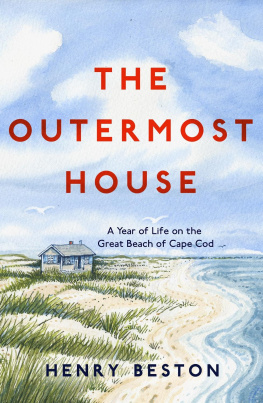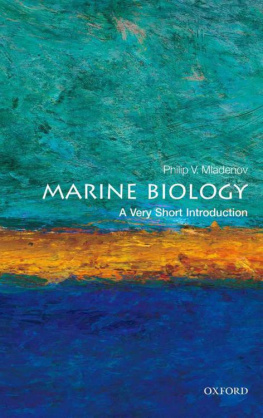
JAMES FISHER, M.A.
JOHN GILMOUR, M.A.
JULIAN HUXLEY, M.A., D.SC, F.R.S.
L. DUDLEY STAMP, G.B.E., D.LITT., D.SC.
PHOTOGRAPHIC EDITOR:
ERIC HOSKING, F.R.P.S.
The aim of this series is to interest the general reader in the wild life of Britain by recapturing the inquiring spirit of the old naturalists. The Editors believe that the natural pride of the British public in the native fauna and flora, to which must be added concern for their conservation, is best fostered by maintaining a high standard of accuracy combined with clarity of exposition in presenting the results of modern scientific research. The plants and animals are described in relation to their homes and habitats and are portrayed in the full beauty of their natural colours.
PROFESSOR HARDY began his marine biologists life over a third of a century ago on his return from service in the first world war. After Oxford and a scholarship to the Stazione Zoologica at Naples, he soon became a member of the Fisheries Department in the Ministry of Agriculture and Fisheries; and, in the middle twenties, served as Chief Zoologist to the R.R.S. Discovery expedition, to the Antarctic seas, making a special study of plankton. His subsequent professorshipsfirst at University College (now the University of) Kingston-upon-Hull; next at Aberdeen; and since 1945 at the University of Oxfordhave brought him the highest academic status and honours, but have not kept him away from his beloved sea. In the closing stages of the writing of this volume, as the editors well remember, he was correcting the typescript, and completing his unique and wonderful colour illustrations, on the deck of the latest Royal Research Ship, Discovery II, scanning the contents of each netting or dredging, sketching new or rare creatures of the sea before their colour faded, applying himself to his research with an enthusiasm excelling that of most naturalists of half his age.
If the editorial board were asked to select from Professor Hardys many scientific qualities that which has contributed most to the creation of this extraordinary book, they would perhaps settle for enthusiasm. Throughout The Open Sea it is quite apparent that he is devotedly obsessed by, and interested in, animals; he is eternally curious about the nature of their adaptations and lives, brilliantly critical in the examination of their mysteries, acutely lucid and at the same time highly artistic in his depiction of them in his remarkable plates. It was a welcome burst of enthusiasm that caused Professor Hardy to write so much and so well of the life of the sea that he has written us two books instead of one. It is the first of these, concerned with the general natural history of the open sea and the world of its plankton, that we here welcome. The second part of The Open Sea concerns the open seas fish and fisheries, and will be published some time in 1957 or early 1958; like the present book, it will be illustrated by Professor Hardys own colour paintings, which represent what no colour-camera has yet been able to catch, and by black and white photographs by that most distinguished marine biologist and skilful photographer, Douglas P. Wilson.
To most readers the subject of this first of Professor Hardys two contributions to our seriesthe world of Planktonwill be relatively unknown and mysterious; but here the enlightened amateur naturalist is shown how, with modest equipment he may investigate it himself. The world of plankton is a world of complex anatomy, much of which can be understood only with the lens of the microscope. The life-histories of the animals are also complicated; some of them are extraordinary. To describe the plankton of our seas, and to set it in its pattern of community, climate, sea-scene and season is a major task. Professor Hardy has brought vast knowledge and experience and scholarship to a synthesis never before attempted.
THE EDITORS
ORIGINALLY it had been intended that the whole natural history of the sea, apart from that of the sea-shore and of the sea-birds already dealt with in the New Naturalist series, should be treated in one general volume. As the writing proceeded, however, it became clear that to do justice to the subject it would be impossible to include all its different elements within a single cover. There is the life of the plankton in almost endless variety; there are the many kinds of fish, both surface and bottom living; there are the hosts of different invertebrate creatures on the sea-floor; and there are those almost grotesque forms of pelagic life in the oceans depths. Then there are the squids and cuttlefish, and the porpoises, dolphins and great whales. In addition mans fisheries now play such an important part in the ecology of our waters that they also must form a part of any general natural history of the sea.
Certainly there is too much material to go into one volume. There occurs, however, a fairly natural division between the teeming planktonic world and the other categories of life it supports: the fish, the whales and the animals of the sea-bed. This first book on the open sea deals mainly with the plankton; it aims at giving the general reader a non-technical account, save for the necessary scientific names, of its many remarkable animals and showing how, with only a little trouble, quite a lot of them may be seen and studied alive. Perhaps to some it may introduce a new world of lifea world so unusual that few of its inhabitants have homely English names at all. It is hoped, too, that it may be a guide to the plankton for university students who are beginning their studies in marine biology. The book also deals with the water-movements and the seasons in the sea; and it contains an account of the squids and cuttlefish, and of those queer creatures, including the deep-water (and often luminous) fish, swimming in the great depths only a little way beyond our western coasts. It will conclude by showing how a study of the plankton is helping us to have a better understanding of the lives of our commercially important fish. Later, and before very long, will come the sequel: a separate volume devoted mainly to fish and fisheries, but also including whales, turtles and other marine animals which are likewise, directly or ultimately, dependent on the plankton for food.
Before going any further I must thank the publishers and editors, not only for all the trouble they have taken over the production of this book, but also for the patience they have kindly shown over my delay in its completion. I accepted their invitation to write it in August 1943, some twelve years ago; it has, however, meant more than the writing. My excuse for its late arrival will be offered after I have made my main acknowledgment.
The value to the book of the remarkable collection of photographs by Dr. D. P. Wilson of the Plymouth Laboratory will be clear to all, but just how wonderful they are and consequently how lucky I am to have them as illustrations, may not at once be fully appreciated by those who are not yet familiar with the living plankton of the sea. Douglas Wilson has long been recognised as the leading photographer of marine life and his beautiful pictures in black-and-white and in colour which graced Professor C. M. Yonges The Sea Shore in this series of volumes will, I am sure, have been seen and admired by most of my readers. I, too, am showing some of his studies of the larger forms of life, such as those of cuttlefish or his unusual view of that strange jelly-fish, the Portuguese-man-of-war, taking a meal; it is, however, his photographs of the tiny plankton animals to which I particularly wish to draw attention here. Though they are taken through a microscope, they are photographs of creatures swimming naturally, very much alive and certainly kicking. Never before has such a series of photomicrographs of living members of the plankton been published; they are unique and will, I believe, be of immense value not only to marine naturalists but to all students of invertebrate zoology. They are the fortunate result of a remarkable combination; Dr. Wilson has brought his skill and artistry to work with that very modern invention the electronic flash. For the first time this device has made possible such instantaneous pictures at a very high magnification. It is not only that invention, however, which makes these pictures unique; while others will follow him, Dr. Wilsons photographs will always have a quality of their own, because he is an artist as well as a scientist. He is not satisfied until he has produced a photograph that has an appeal on the score of composition as well as on that of scientific value. All his photographs except two (the stranded jelly-fish and squid) are of living animals. A few excellent black-and-white pictures by other photographers are included in some of the plates and these are acknowledged in the captions or the text.
Next page











